There’s a lot to consider when shopping for a non-toxic high chair (as if you didn’t have enough to think about with your sleep-deprived brain!). Do you want one made of plastic or wood? How much do you want to spend? How can you tell whether a specific high chair is made using toxic materials or not?
Well, we’re hoping to make your life a tiny bit easier by doing the research for you and creating this complete guide to non-toxic high chairs. We’ll go through what to avoid, what to look for, and other random things to consider, and then give you our recommended brands to check out, complete with pros and cons.
Click here to skip right to our recommendations.
RELATED: The best non-toxic cribs and crib mattresses
Table of Contents
- What to AVOID in a High Chair
- Plastic or No Plastic?
- PVC (Polyvinyl Chloride)
- Polyurethane (PU) Foams
- Flame Retardants
- Formaldehyde and Composite/Engineered Woods
- Harsh Paints & Finishes
- Overall Lack of Transparency
- What Else to Look for in a Non-Toxic High Chair
- Third-Party Material Certifications
- Stability & Safety Standards
- Adjustability
- Affordability
- Easy to Clean
- Size, Footprint, and Storage Ability
- Your Specific Needs and Preferences
- These Are the Best Non-Toxic High Chairs
- Stokke Tripp Trapp
- Lalo
- PlanToys
- Joovy (Most Affordable Non-Toxic High Chair)
- Keekaroo
- Nofred
- Monte Design
- Abiie
- Nuna
- Amish Wooden High Chairs
- Best Non-Toxic Booster Seats for Eating at the Table
- Best Non-Toxic Hook-On Chair
- Lastly: Are IKEA’s High Chairs Non-Toxic?
- Conclusion
This post may contain affiliate links, which means we may earn a small commission if you choose to make a purchase. We only make recommendations that are genuine and meet our standards.
Featured image: Nofred
What to AVOID in a High Chair
Plastic or No Plastic?
When shopping for high chairs, you’re going to have to decide whether you want one that’s made with plastic or one that’s completely plastic-free. Some high chairs are made almost entirely of plastic, others are made of a plastic and wood combo, while others are made of 100% wood.
We all know by now that plastic isn’t great for our individual or our collective health. Here at The Filtery, whether or not we include plastic products in a specific article depends on a number of different things. For example, are plastic-free alternatives even available? Are there benefits to using plastic for that specific category of product? Sometimes it’s not exactly a black-and-white issue.
It’s important to remember that plastic is not all-bad. While (largely cheap, single-use) plastic is wreaking havoc on our ecosystems and human health, the plastic used in medical equipment also saves a countless number of lives each year. Plastic can also make products more affordable, accessible, and lightweight. Additionally, some types of plastic are more toxic than others (we’ll get to that in a minute).
When it comes to high chairs specifically, here are some of the benefits of plastic:
- It tends to be easier to clean
- It can be more water-proof and therefore resistant to mold and mildew
- It’s lighter weight than wood and therefore easier to move around, store, and travel with
One thing to keep in mind while choosing a high chair is that, as a general rule, hard plastic tends to be safer than softer plastic. Toxic phthalates, for example, are often added to plastic in order to make it more flexible. For this reason, a plastic high chair is likely going to be safer than, say, a plastic backpack, or a shower curtain, or an artificial Christmas tree.
But that doesn’t mean that hard plastic can’t still contain phthalates and/or other toxic plasticizers. (After all, plastic is still a petroleum product, which is not great…) If you do decide to go with a plastic option, just make sure you choose a brand that explicitly uses BPA- and phthalate-free plastic.
Phthalates are endocrine disruptors, which means they can interfere with one’s natural hormone function and lead to infertility and developmental toxicity. They’re also linked to things like diabetes and asthma, and also may be carcinogenic.
PVC (Polyvinyl Chloride)
PVC is water-resistant, which is one reason why it’s used in things like high chairs (primarily in parts like the seat cushion cover). But PVC is one of the most toxic kinds of plastic.
PVC contains chlorine, which creates toxic byproducts called dioxins and furans. According to the World Health Organization (WHO), dioxins “can cause reproductive and developmental problems, damage the immune system, interfere with hormones and also cause cancer.”
Not only that, but PVC almost always contains phthalates, too.
Polyurethane (PU) Foams
It’s not uncommon to find high chair seat cushions made from polyurethane foam. There are different kinds of polyurethane, and some of them are more toxic than others (the problem is that it’s almost always impossible to know what kind is used in a specific product).
PU foams are petroleum products that often contain volatile organic compounds (VOCs) like benzene, toluene, and formaldehyde. Many of these VOCs are known carcinogens and when you have them in your home, they slowly leak out into your air over time.
Not only that, but PU foam also contains isocyanates with long names like toluene diisocyanate (TDI) and methylene diphenyl diisocyanate (MDI), which are powerful irritants and sensitizers.
Go for a high chair without a cushion, or choose safer materials like natural latex, rubber, and/or organic cotton instead.
Flame Retardants
A lot of furniture is treated with chemical flame retardants (especially those made with PU foams since it’s so flammable). These flame retardants are associated with pretty much every type of health concern you can think of, from endocrine disruption and infertility, to lower IQ and cancer, and more.
Try to buy from a high chair brand that does not use flame retardants at all.
Formaldehyde and Composite/Engineered Woods
If you’re going to go for a wooden high chair, make sure it’s made out of real, solid wood as opposed to engineered wood (composites, plywood, MDF, particleboard, etc.).
Engineered woods are made by essentially gluing together a bunch of wood chips, pieces, and sawdust to make them look and feel like solid wood. The problem is that most of that glue contains formaldehyde, which is a known carcinogen.
Harsh Paints & Finishes
Another thing to keep in mind if you’re going to go for a wooden high chair is what it’s finished with. Almost all wooden furniture has to be finished with something, but it’s all the more important for high chairs. A finish helps to prevent splinters, increase water resistance (and therefore mold and mildew), and makes cleanup a lot easier.
But a lot of wood finishes, paints, and lacquers can be toxic… They can contain a whole host of VOCs, such as toluene, benzene, xylene, petroleum distillates, and more.
Look for brands that use natural finishes like linseed oil, water-based paints and lacquers, and no- or low-VOC finishes.
Overall Lack of Transparency
One of the very first things we look for when researching products of any kind is how transparent the brand is about things like what types of materials and ingredients they use, how they are sourced, etc.
Popular brands like Fisher Price and Graco, for example, aren’t on this list because we have no idea what their (mostly plastic) high chairs are actually made of. Consumers deserve to know what’s in the products they buy and use, and when brands don’t offer up that information, that’s usually a yellow flag that they can’t be trusted.

What Else to Look for in a Non-Toxic High Chair
Third-Party Material Certifications
In addition to choosing safer plastics (like BPA-, phthalate-, and PVC-free) and solid wood (instead of engineered), you can also look for third-party certifications like GREENGUARD and OEKO-TEX, which indicate that a product has been verified by a third party to be free from a list of toxins and contaminants. (The OEKO-TEX certification is only applicable to fabrics, so look for this one on things like high chair cushions. GREENGUARD and GREENGUARD Gold certify an entire product.)
California’s Prop 65 warning label is another good one to look for when shopping for non-toxic high chairs. If a product is Prop 65 compliant, that means it does not contain toxic levels of a long list of natural and synthetic materials, including things like lead, BPA, and a ton of other chemicals.
Stability & Safety Standards
In addition to safe materials, the other really important thing to consider when shopping for a high chair is stability and general consumer safety standards. Here are the certifications to look for in this regard:
These standards look at things like stability and support, weight-bearing load, latching and locking mechanisms, pinching and trapping abilities, protrusions, and more.
Adjustability
A lot of standard high chairs are basically one-size-fits-all. But the cool thing about a lot of the recommended non-toxic high chairs listed below is that they’re adjustable in various ways. Many of them can be transformed as your child grows. Some can turn into regular chairs after you’re finished using them as a high chair. Some brands also offer extra parts and accessories so they can be used with newborns.
Adjustable high chairs tend to be more expensive, but they can also make your life a lot easier in the long run.
Affordability
Unfortunately, non-toxic high chairs do tend to be more expensive than their alternatives. The most affordable high chair on our list is Joovy’s Nook High Chair, which comes in at $129. IKEA’s high chairs, in contrast, start as low as $15. But unfortunately, those aren’t entirely non-toxic…
One important thing to consider when deciding how much to spend is the fact that a lot of the high chairs listed below are not only much more durable but can also be adjusted as your child grows, even transforming into regular chairs for older kids, teens, and adults. (IKEA’s high chairs definitely cannot do that.) So if you can afford it, you can think of it as more of a long-term investment that’s going to last you a really long time.
The non-toxic high chairs listed below tend to have a pretty nice resale value, so there’s a good chance you will be able to get at least some of your money back after you’re finished using it.
In that same vein, if the options below are out of your price range, you may want to consider checking secondhand marketplaces such as Facebook and Mercari to see if someone else is selling a high chair from one of our recommended brands. You might be able to get your hands on a lightly used non-toxic high chair at a deeply discounted price!
Easy to Clean
This is, of course, a very important thing to consider, especially considering that your high chair will likely need to be cleaned after almost every time it’s used. Not only will an easy-to-clean high chair make your life a lot easier but it will also help to prevent things like mold growth. Usually, the fewer cracks snd crevices, the better. Nuna’s ZAAZ high chair, for example, has a completely crevice-free design, which is pretty cool!
Size, Footprint, and Storage Ability
Some high chairs have a lot larger footprint than others. Think about your kitchen size, space, and layout to decide whether you’d prefer to have a more traditional-looking high chair with wide legs like the Lalo or a more narrow one like the Stokke Tripp Trapp.
Also consider whether your high chair will serve as a more permanent piece of kitchen furniture or whether you will need to frequently fold it up and stow it away (if that’s the case, the Joovy Nook might be a good option for you).
Also, consider whether or not you will need to travel much with your high chair (like on vacation or to your in-laws’). If so, you might consider the Stokke Clikk, which can be easily taken apart and put in a convenient travel backpack.
Your Specific Needs and Preferences
Lastly, think about any other specific preferences you and your family might have. Tray or no tray? How important is a footrest? Do you want a high chair that can recline with your newborn? How important is the aesthetic and whether or not it matches the rest of your kitchen design?
Alright… Now that we’ve covered just about everything there is to consider about a high chair, let’s get on to our recommendations!
These Are the Best Non-Toxic High Chairs
Stokke Tripp Trapp

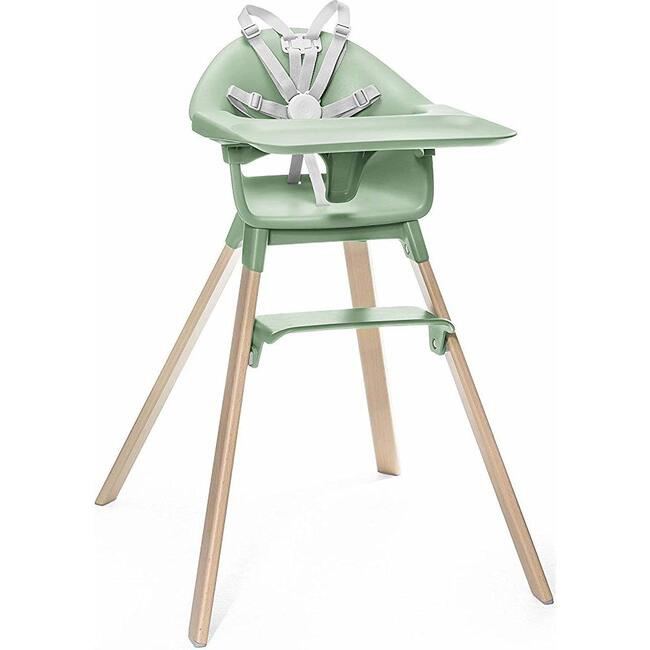
Price: $199+
Fits: Newborn to adulthood (up to 300 pounds!)
Stokke actually carries three styles of high chair: the Clikk, the Steps, and the Tripp Trapp. They’re pretty different from each other though, so we’re going to talk about the Tripp Trapp first (our favorite), and then we’ll get to the other two.
The Tripp Trapp is an adjustable wooden high chair, and it’s definitely a favorite among parents. It was actually designed back in 1972 and was the first high chair of its kind (other brands have since modeled their designs off of this one). One of the best things about it is that it can fit a baby, child, or adult of any age!
For newborns, you can get an ergonomic cradle that attaches to the top of the chair. Once your baby reaches six months of age, you can get a Baby Set with an optional tray, which keeps baby secure until they’re about three years old. After that, you can remove the seat and straps and adjust the height of the chair as needed while your child grows.
For safety, all of Stokke’s high chairs are certified by JPMA and meet or exceed all ASTM safety standards. They’re produced in the E.U. (where standards tend to be stricter than other parts of the world).
The bulk of the chair is made out of beechwood, which is required to meet E.U. Timber Regulations to help support a responsible wood industry. Other pieces include plastic and silicone, but everything is free from toxic substances like phthalates and formaldehyde. They used non-toxic, water-based paints, and their cushions are made from organic cotton.
The chairs and accessories are available in a wide variety of colors, from natural wood, white, and black to bold red and bright mint.
Stokke carries two other high chair designs as well: the Clikk and the Steps. These ones aren’t as adjustable as the Tripp Trapp, but they might be a good fit for some families, depending on what you’re looking for!
The Clikk fits kids from 6 to 36 months and has more of a “typical” high chair design. One of the main selling points of the Clikk is that it’s lightweight and can be easily taken apart and put into this travel bag for easy transportation, say, to grandma’s house or on vacation.
The Steps chair can be used for babies and then adjusted as the kids grow. But it’s specially designed with active toddlers in mind since you can make it easy for them to climb in and out of.
PROS
- Can adjust to fit a person of literally any age
- Lots of accessories that can be added and removed based on you and your child’s preferences
- Narrow with a small footprint
- Timeless Scandinavian design
CONS
- Can get expensive when you add up the chair plus all of the different accessories needed to adjust for age
Lalo


Price: $175-$255
Fits: The High Chair is meant for babies who can sit up on their own and are ready to start solids (usually between 4-6 months), and can be used by kids up to 3 years old or 33lbs. After that, you can transition the High Chair to a Play Chair for older toddlers and kids.
Lalo’s high chair is made out of BPA-free and food safe plastic (the seat and tray), FSC-certified sustainable beech wood (the legs), and cotton (the cushion). The crossbar is made out of aluminum and the straps are made of polyester (which is not always ideal, but in this case is great for an easier clean and mold resistance). It’s all Prop 65 compliant, which says a lot because California’s Prop 65 standards are pretty strict!
When it comes to safety and comfort, Lalo’s high chair includes a 5-point harness, belly bar (for pulling the chair up to the kitchen table without a tray), and footrest. All of their products meet and exceed ASTM safety standards.
One of the best things about this high chair is that it converts into a play chair once your child outgrows it. You can purchase additional Play Chairs and/or the Play Table to complete your set.
Lalo also carries complementary accessories like super cute silicone bibs, tableware, and more.
Lalo’s products are designed in New York and Scandinavia and made in China. While we don’t love to see products made overseas, the Lalo team assures its customers that they carefully chose a family-owned factory that’s been producing baby goods for over 70 years. Manufacturing in China likely helps to keep the products at a more affordable price point for consumers as well.
Click here to read our full review of the Lalo High Chair.
PROS
- Easy to assemble
- Easy to clean (some parts are machine washable and dishwasher safe)
- Has 5 different settings
- Converts to a play chair after your baby outgrows the high chair
- Beautiful, minimalistic aesthetic
- Comes with 100-day risk-free trial
CONS
- Design of the chair might make it difficult for smaller babies to reach their food
- Straps are kind of flimsy
- Tray is not adjustable & requires two hands to remove
Home
An Honest Review of the Lalo High Chair (aka “The Chair”)
The Lalo High Chair definitely has a lot going for it, along with a few shortcomings. After trying it out for several weeks, I’ve put all of my honest thoughts together for you here in the hopes that it will help you decide whether The Chair will be a good fit for you and your little one.
PlanToys
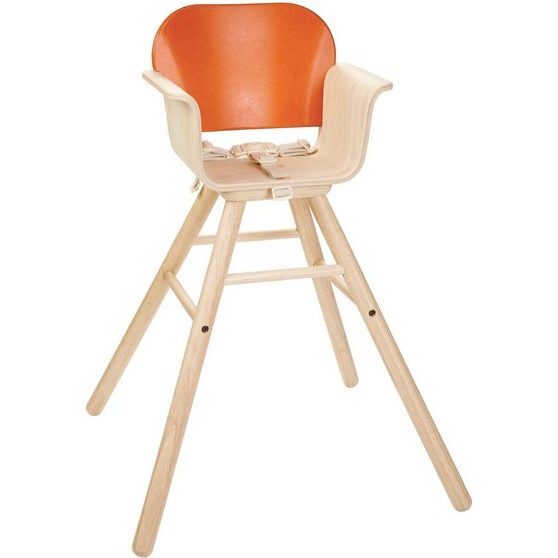
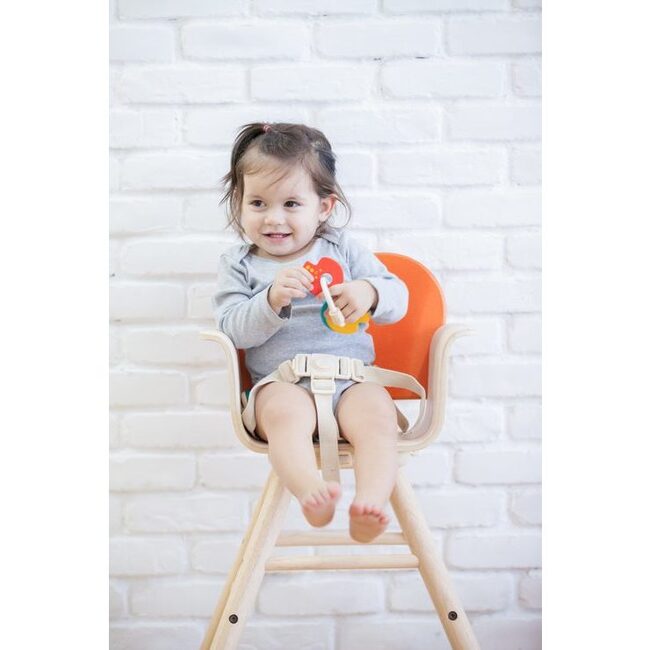
Price: $160
Fits: 6 months – 3 years
If you’d prefer a completely plastic-free high chair, this one from PlanToys is a great option. It’s made out of natural rubberwood, which is preservative-free and naturally processed, along with non-toxic paint. This high chair has been tested according to both the EN71 and ASTM safety standards.
PlanToys is a really great brand when it comes to sustainability and ethics as well. (Almost) everything is made ethically in Thailand so they can invest in the local communities there, while also keeping their carbon footprint down by sourcing materials from the same area where the products are actually manufactured. They also use renewable energy when possible and most of their products and packaging are biodegradable.
PROS
- Made from natural solid rubber wood instead of plastic
- Sustainable and ethical brand
CONS
- Does not come with a tray (it’s meant to be used at the table with the rest of the family)
- 3-point harness (other brands have a 5-point harness)
Joovy (Most Affordable Non-Toxic High Chair)


Price: $129-$239
Fits: 0 to 48 months (or 50 pounds)
Coming in at $129, Joovy’s Nook High Chair is the most affordable non-toxic high chair on our list.
Joovy actually carries several different high chair options so you can choose based on your budget and priorities:
- The Nook High Chair ($129) has a foldable, space-saving design for convenient storage and travel. (Get it? It fits in any “nook”!) This one fits babies from 6 months up to 50 pounds. It comes in turquoise, red, coral, black, charcoal, and a Southern Sea Otter National Park Foundation Edition! No assembly is required!
- The Nook Newborn High Chair ($189) is similar, except that (as the name indicates), it’s suitable for newborns up to 50 pounds (or 48 months). This one folds flat for storage just like the regular Nook, but it also has a 3-position recline seat and wheels (which the standard Nook does not have). It comes in pink, yellow, black, and grey.
- Lastly, the Foodoo Hair Chair ($240) is also newborn safe (up to 50 pounds), reclinable, and has eight different height positions so that it can fit tables and counters of any height. Additionally, it comes with a two-position adjustable footrest. It has front wheels like the Nook Newborn and it does fold up, but not quite as tightly as the other two chairs.
All of Joovy’s non-toxic high chairs come with 5-point seat harnesses for safety along with dishwasher-safe swing trays that can be opened with one hand. They’re all completely free from BPA, BPS, phthalates, and other endocrine disruptors as well as lead and flame retardants.
PROS
- Little to no assembly (depending on which chair you get)
- 5-point seat harness
CONS
- Smaller babies may need a boost so they can reach the tray
- Kids grow out of it once they exceed 50 pounds
Keekaroo


Price: $189-$239
Fits: 6 months to adulthood
Keekaroo’s narrow design is similar to Stokke’s Tripp Trapp; it can be adjusted in 1-inch increments as your child grows and then can become a regular chair for older kids and adults. It even fosters proper hip and back placement to encourage healthy posture.
For safety, the chair is JPMA certified to the highest ASTM standards for children up to three years old. They offer three different solid wood variations (Natural, Mahogany, Espresso) and a BPA-free plastic tray. The chairs are finished with a water-based, low-VOC lacquer (without any pigments or lead), which makes the chairs water- and mold-resistant without the harsh chemicals.
They also carry booster seats for toddlers and young kids which are free from latex and PVC, as well as BPA and phthalates… but still easy to clean!
PROS
- Made in the USA
CONS
- Doesn’t have as many accessories as the Stokke (for example, it can’t be used with a newborn)
- 3-point safety harness (others have 5)
Nofred

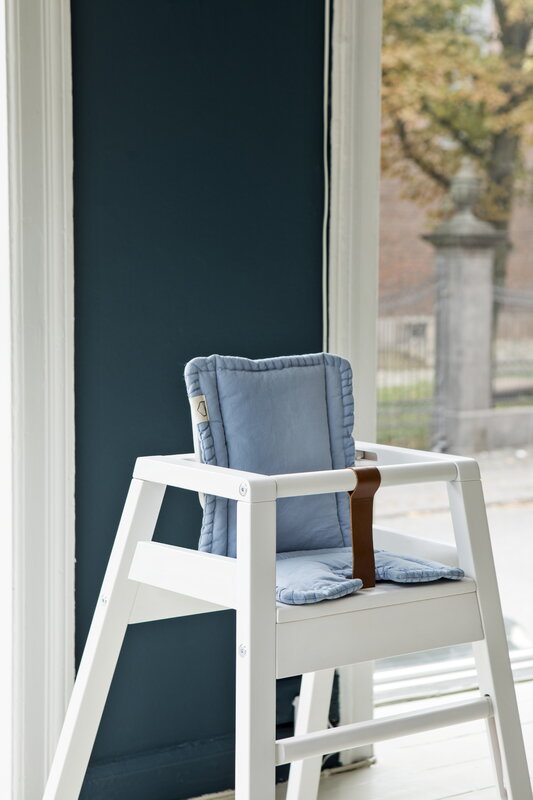
Price: $365
Fits: 6 months to 3 years
These Robot High Chairs are so cute! This is one of the only completely plastic-free high chairs on our list. It has an adjustable back and footrest, and the front bar can be removed once your child gets old enough, too. It comes in three different colorways (grey, white, and wood).
It’s made out of beech wood with a non-toxic lacquer and leather strap. It has been tested at the Danish Technological Institute and meets all European safety regulations.
Plus, you can get an organic cotton seat cushion to go with the chair, which is available in lilac, beige, or blue.
PROS
- Completely plastic-free
- Optional organic cotton chair cushion
- Minimalistic design
CONS
- Does not come with a tray (it’s meant to be used at the table with the rest of the family)
- More expensive than many others
- 3-point harness (many others have 5)
Monte Design


Price: $595
Fits: 6 months – 3 years
Another great option for a wooden high chair, this one is GREENGUARD Gold certified, which means it’s been screened for more than 10,000 chemicals and emissions. All of their fabrics are also either OEKO-TEX Standard 100 certified and/or REACH compliant.
Along with the rest of their products, Monte Design’s high-chairs are handcrafted in Toronto, Canada using LEED, FSC Certified, and locally sourced hardwood (with no formaldehyde) and water-based, biodegradable glues.
It does contain foam, which we usually try to avoid, but we like that it’s GREENGUARD Gold certified, low-VOC, and free from all flame retardants.
The seats come in several different neutral colors, including white, black, brown, grey, and tan. For the wooden part, you can choose between clear maple, espresso, and walnut.
A member of the Sustainable Furnishings Council, Monte Designs tries to implement as many ethical, eco-friendly, and conscious initiatives throughout their entire supply chain and manufacturing processes.
PROS
- GREENGUARD Gold certified non-toxic
- No assembly required
- Minimalistic design that actually looks good in your home
CONS
- Expensive
- Cannot be adjusted for height
- Child will grow out of it after 3 years
- Does not come with a tray (it’s meant to be used at the table with the rest of the family)
Abiie


Price: $200
Fits: 6 months all the way to adulthood
Abiie’s Beyond Junior Y High Chair is made out of European beechwood and comes with “EZ-Seat technology” which not only makes for easy cleaning but also enables super-quick seat adjustment.
You can get this high chair in a few different colors, including Rasberry, Olive, Blueberry, Black, and Cream. It comes with a removable, dishwasher-safe tray cover as well.
For safety, this wooden high chair has a dual restraint system, so you can use it either with a 3-point or 5-point harness. It’s free from BPA and phthalates as well as PVC and latex. It’s finished with a non-toxic and certified-safe plant-based lacquer. It also complies with ASTM standards as well as the California Air Resources Board (CARB) Phase 1 and 2.
PROS
- Adjustable from 6 months all the way to a regular chair that can hold an adult
- Optional 3-point or 5-point harness
- You can buy replaceable parts to make your chair last longer
CONS
- Some users report that the different parts and tight cracks make it difficult to clean
Nuna
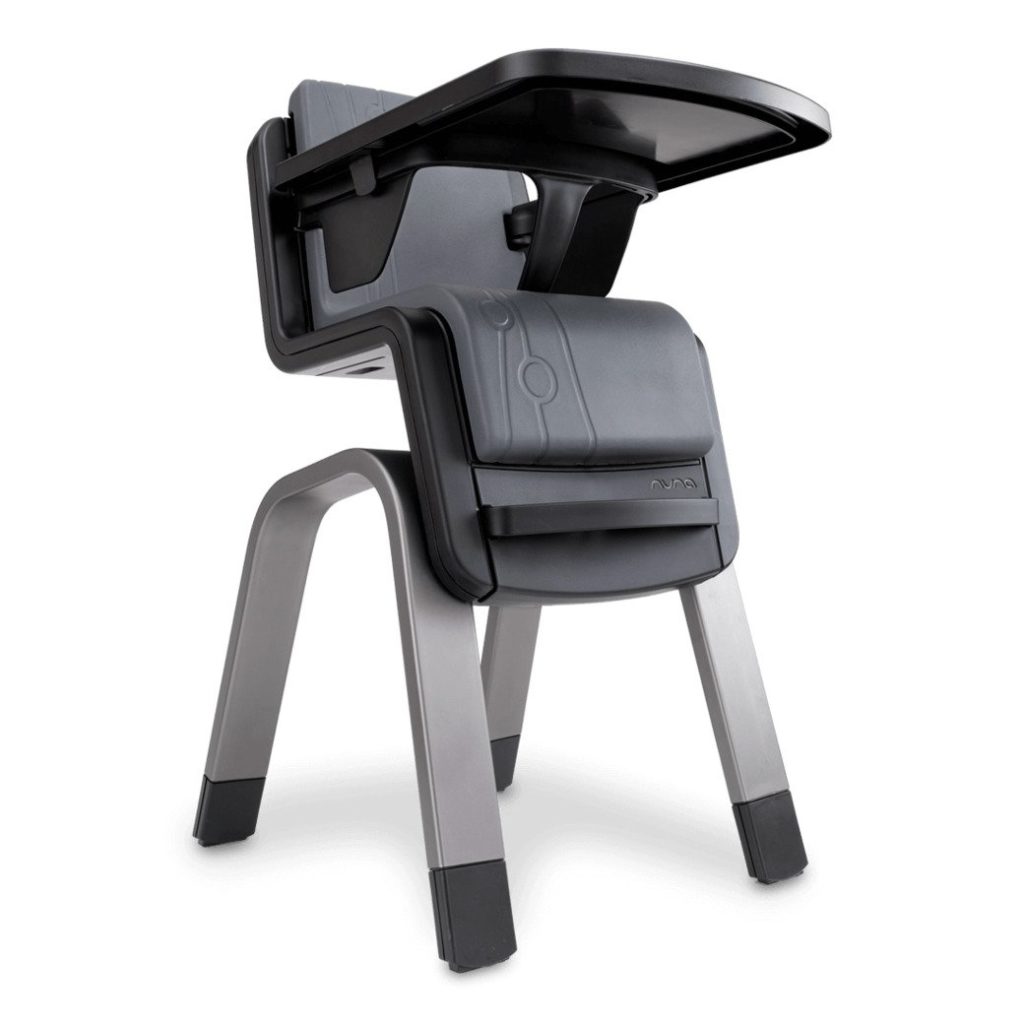

Price: $300
Fits: Babies who can sit up and on to bigger kids and adults
This is another great option for an adjustable high chair that can be used for your child’s entire life. It’s made mostly of plastic, but it’s free of BPA, PVC, and DEHP. Available colors include jade + white and pewter (black + grey). **Note that while Nuna says their chairs are free from certain endocrine disruptors, it’s not clear whether or not they are 100% free from ALL phthalates.**
This one is super easy to clean with its anti-crevice design and removable plastic parts that you can throw in the dishwasher. Nuna takes a lot of measures when it comes to product safety as well.
PROS
- No-crevice design for better cleanup and mold prevention
- Optional 3-point or 5-point harness for safety
- Unique, futuristic aesthetic
CONS
- More expensive than a lot of other options
- Not explicitly 100% phthalate-free
Amish Wooden High Chairs


Another great option to consider would be an “old-fashioned” Amish wooden high chair. In addition to being completely plastic-free, Amish wooden furniture is made out of solid wood instead of toxic engineered/composite wood (you can read more about that here). It’s also handcrafted in America.
Some Amish crafters use finishes that contain harsh chemicals, while others use more natural finishes like linseed oil. But the thing that really sets Amish crafters apart from pretty much everyone else on this list is that you can almost always ask for customizations. So if you want to look into an Amish wood high chair, don’t hesitate to reach out to one of the companies below and ask them to use only a non-toxic and natural finish on your chair!
PROS
- Handmade in the USA from solid wood
- Completely plastic-free
- Can be customizable with lots of different options
CONS
- Heavier and more difficult to store than other chairs
- Can be more expensive (usually in the $200-$500 range)
Here are a few different shops offering a variety of customizable Amish wooden high chairs:
- Amish Outlet Store (based in Ohio)
- Foothills Amish Furniture (based in South Carolina)
- Barn Furniture (based in California)
Best Non-Toxic Booster Seats for Eating at the Table
There are a lot of booster seats out there, but there are only two we’ve found that are explicitly free from things like BPA and PVC. So when your child grows up and is ready to join you at the dining room table in a real chair, here are our picks for table booster seats:
Keekaroo

Price: $60
This non-toxic booster seat is free from latex, PVC, BPA, phthalates, formamide, and other toxins. It’s suitable for toddlers and kids aged 12 months to four years.
Made in the USA, these boosters are JPMA Certified and are guaranteed to be peel-resistant and tear-resistant. It comes in a variety of colors, from grey and cream to pink, blue, and green.
Babybjorn

Price: $40
Babybjorn used to have a high chair, but it was apparently discontinued because it didn’t meet certain safety requirements (not a great sign!).
However, this popular baby brand does carry a BPA- and PVC-free booster seat with a slick design. It’s suitable for kids 3 and up, meets ASTM safety standards, and has lots of positive reviews from users!
Best Non-Toxic Hook-On Chair
If you’re in the market for a hook-on chair instead, there’s one brand that’s transparent about the materials they use (and the toxins they leave out).
Inglesina

Price: $79
Fits: Children between 6 and 36 months; up to 37lbs
It’s hard to find a non-toxic hook-on chair, but Inglesina has a good one! Great for travel, this lightweight chair hooks onto most tables and comes with an integrated carrying bag.
Like Inglesina’s other products, it is made out of plastics and synthetic materials, but it’s free from BPA, phthalates, lead, flame retardants, or other toxins such as methyl biphenyl diisocyanate (MDI), toluene diisocyanate (TDI), or TDCPP.
Lastly: Are IKEA’s High Chairs Non-Toxic?
I know you’d probably wondered about IKEA’s high chairs (they’re so affordable and accessible!). But unfortunately, none of IKEA’s high chairs are totally non-toxic. They use polypropylene and other plastics, polyester and polyester powder coatings, acrylic lacquers, and fiberboard (a.k.a. engineered wood) in their high chairs.
In general, IKEA’s furniture has pros and cons… They have some pretty good restrictions on things like PFAS and some phthalates, but they lack transparency in other ways. You can read our full breakdown here!
Home
Is IKEA Furniture Non-Toxic?
Is IKEA’s furniture non-toxic? Does it contain toxic chemicals like flame retardants, PFAS, formaldehyde, or phthalates? We’re giving you all the answers!
Conclusion
Your baby is likely the most important thing in your life, and when there are so many things to consider, it can be a bit overwhelming to shop for a non-toxic high chair! Hopefully this guide has helped you on your quest for a non-toxic high chair that fits with your lifestyle. If there are any specific high chair brands you’re wondering about, let us know in the comments and we’ll investigate!
Image credits: all product photos belong to respective brands.




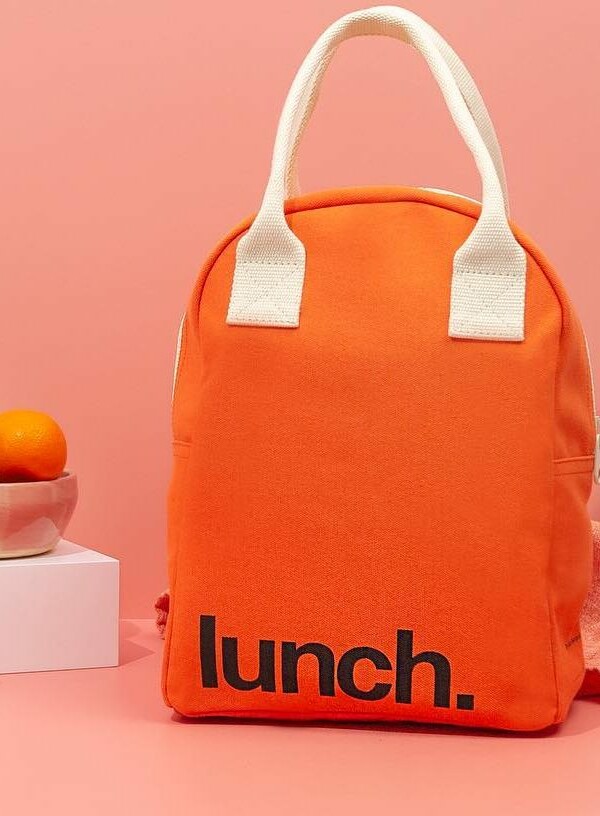


Hi ,
Have you done any research on Play Chairs for toddlers?
It seems its hard to find a Non Toxic play chair and one that properly supports the back of a child.
Thanks
Hi Susan,
Actually, Lalo’s high chair can be converted into a play chair! (You can read more about that here: https://thefiltery.com/lalo-high-chair-review/). I haven’t looked extensively into other play chair brands, but I will add it to my to-do list. 🙂
Hi I wanted a reclining high chair in the Uk. I have seen the maxi cosi minla chair but nothing on if it’s toxic or not?
Hmm.. Yea Maxi Cosi barely gives any info about their materials. One of the Joovy Nook reclines and it looks like they do ship internationally (even though there might be duties to pay). Stokke is available in the UK and their Steps Chair might work for you, but I think it depends on the age of the child. I think the reclining option really only works for babies, not toddlers and older.
Any ideas for a non toxic high chair for 36” high table, so seat needs to be about 28”?
Thanks!
Hi there,
It looks like the Stokke or the Keekaroo MIGHT be tall enough. If not, I would recommend trying to reach out to one of the Amish furniture brands to see if they can make you a custom one!
Hello! I’m an expectant mom of twins and I was thrilled when a co-worker gave me her two used high chairs from when she had her twins! The brand is Cosco, which I wouldn’t be surprised if it’s full of toxins, unfortunately. Would there be a way I could “detoxify” the high chairs or maybe use a cover of some type when placing the babies in them? We’re on a tight budget and I’m very willing to accept any hand-me-down items as long as they can be “detoxified” as much as possible.
Thanks so much!
Hi Laura! There’s probably not much you can really do to “detoxify” the chairs, but here are a few things I’d offer you:
– If the tray is plastic, you could do your best to use silicone dishes and mats to keep the food from touching the tray. (I know that might be difficult with little ones, though!)
– If it’s wood, you could potentially look into covering it with something like an AFM sealer, which is meant to essentially “lock in” VOCs. (If you do that, though, I would reach out to them first and ask their opinion on using it on a high chair because these products are more meant for things like furniture and flooring and I’m not sure if they’re food safe.)
– Most importantly, I would say to be try and easy on yourself and just do what you can. It’s impossible for any of us to live a 100% non-toxic lifestyle (or provide that for our babies, unfortunately). I think it’s totally reasonable to use secondhand high chairs for both budget and sustainability reasons. You may try to accept that this specific thing is something you just don’t have a ton of control over and focus instead on things like what you’re actually putting in and on your babies’ skin and bodies (soaps, lotions, organic foods, filtered water, etc.) I think in the grand scheme of things, your money and energy may be better spent on those types of things for now. I know you want your best for your babies and you are going to do the best you can with what you have available! I hope that helps a little bit. <3